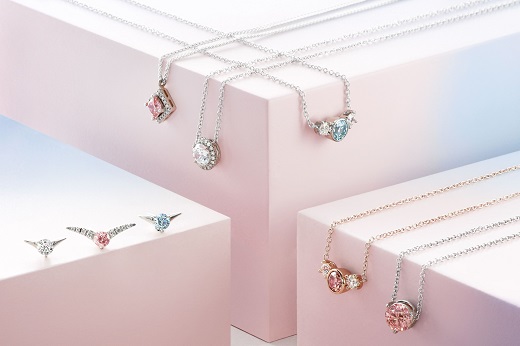Lab-Grown Production Rising 15% Per Year
 RAPAPORT... Production of lab-grown polished diamonds could grow to 17 million carats annually, taking a significant chunk of the market for small stones, according to Bain & Company. The synthetics industry currently has the capacity to produce about 2 million carats of gem-quality, lab-grown polished per year, the majority of which is under 0.18 carats, Bain estimated in its 2018 Global Diamond Report it published Wednesday in partnership with the Antwerp World Diamond Centre (AWDC). Output could grow to between 10 million and 17 million carats per year by 2030 if the sector sustains its current annual growth rate of 15% to 20%, the researchers claimed.That improvement is being driven by rising consumer demand and attractive economics as production costs have dropped. Today, it costs $300 to $500 per carat to produce a lab-grown diamond through the method of chemical vapor deposition (CVD), compared with $4,000 per carat in 2008, Bain reported.Reduced costs have led to lower retail prices, with gem-quality lab-grown diamonds selling for half the price they did two years ago, the report continued. Wholesale prices have dropped threefold, it added.Prices are likely to decrease even further as production efficiencies improve, new competitors enter the market, and the segment commoditizes, Bain predicted. The market has seen a rise in interest in lab-grown diamonds in 2018, after De Beers, the largest diamond miner by value, announced it was launching a line of lab-grown-diamond jewelry called Lightbox. That, along with the US Federal Trade Commission's removal of the word "natural" from its definition of a diamond, has significantly impacted the way consumers view lab-grown diamonds, Bain stressed. However, it's not just rising consumer demand that is driving up production, as lab-grown diamonds also have applications in high tech, such as for sensors, semiconductors and medical cutting tools. In fact, these present lab-grown producers with the highest potential for long-term growth and profitability, Bain added. For the jewelry market, it's still unclear the full effect lab-grown diamonds will have on the natural diamond industry. The declining cost of production will make the challenge harder, with the melee market likely to be the biggest victim, the report added. The researchers believe lab-grown diamonds will be limited to 5% to 10% of the total diamond-jewelry market if the natural-diamond trade embarks on effective marketing that makes a clear distinction between the two products."Marketing could uphold the value of natural diamonds, especially if the prices of lab-grown diamonds continue to drop," Bain concluded. "It's probable that consumers will view lab-grown diamonds as fashion jewelry but not luxury goods, limiting the effect on natural-diamond demand." Image: Lightbox jewelry. (De Beers)
RAPAPORT... Production of lab-grown polished diamonds could grow to 17 million carats annually, taking a significant chunk of the market for small stones, according to Bain & Company. The synthetics industry currently has the capacity to produce about 2 million carats of gem-quality, lab-grown polished per year, the majority of which is under 0.18 carats, Bain estimated in its 2018 Global Diamond Report it published Wednesday in partnership with the Antwerp World Diamond Centre (AWDC). Output could grow to between 10 million and 17 million carats per year by 2030 if the sector sustains its current annual growth rate of 15% to 20%, the researchers claimed.That improvement is being driven by rising consumer demand and attractive economics as production costs have dropped. Today, it costs $300 to $500 per carat to produce a lab-grown diamond through the method of chemical vapor deposition (CVD), compared with $4,000 per carat in 2008, Bain reported.Reduced costs have led to lower retail prices, with gem-quality lab-grown diamonds selling for half the price they did two years ago, the report continued. Wholesale prices have dropped threefold, it added.Prices are likely to decrease even further as production efficiencies improve, new competitors enter the market, and the segment commoditizes, Bain predicted. The market has seen a rise in interest in lab-grown diamonds in 2018, after De Beers, the largest diamond miner by value, announced it was launching a line of lab-grown-diamond jewelry called Lightbox. That, along with the US Federal Trade Commission's removal of the word "natural" from its definition of a diamond, has significantly impacted the way consumers view lab-grown diamonds, Bain stressed. However, it's not just rising consumer demand that is driving up production, as lab-grown diamonds also have applications in high tech, such as for sensors, semiconductors and medical cutting tools. In fact, these present lab-grown producers with the highest potential for long-term growth and profitability, Bain added. For the jewelry market, it's still unclear the full effect lab-grown diamonds will have on the natural diamond industry. The declining cost of production will make the challenge harder, with the melee market likely to be the biggest victim, the report added. The researchers believe lab-grown diamonds will be limited to 5% to 10% of the total diamond-jewelry market if the natural-diamond trade embarks on effective marketing that makes a clear distinction between the two products."Marketing could uphold the value of natural diamonds, especially if the prices of lab-grown diamonds continue to drop," Bain concluded. "It's probable that consumers will view lab-grown diamonds as fashion jewelry but not luxury goods, limiting the effect on natural-diamond demand." Image: Lightbox jewelry. (De Beers)